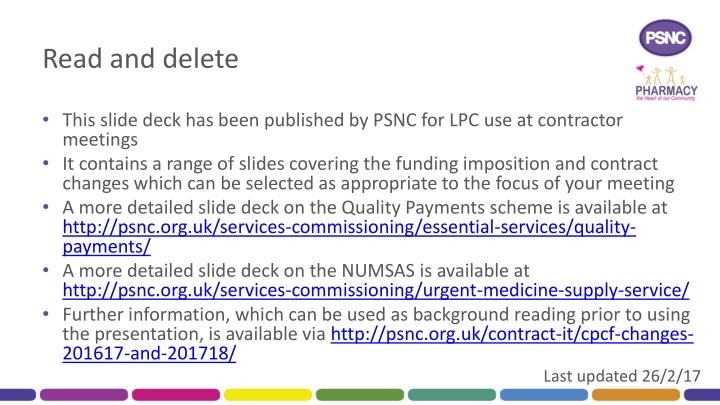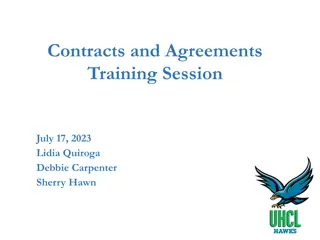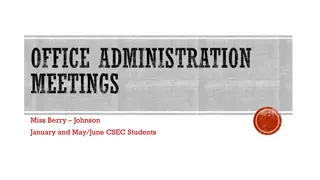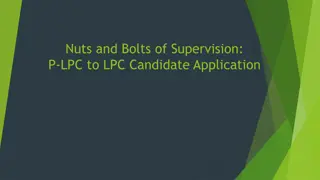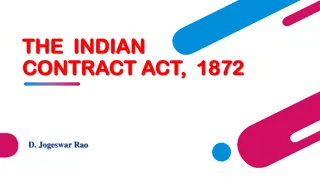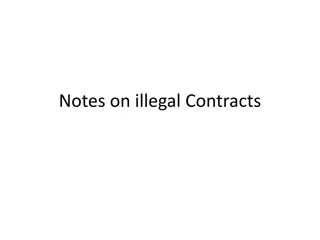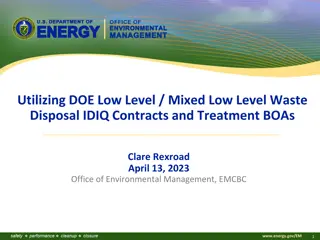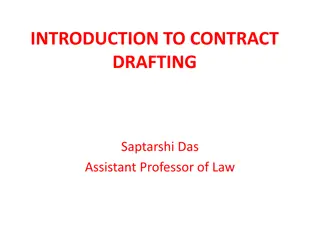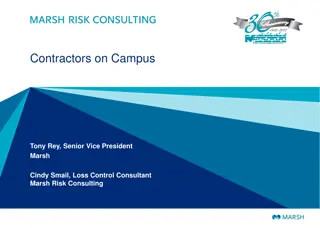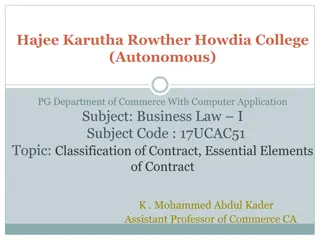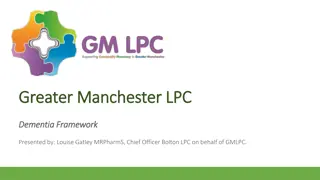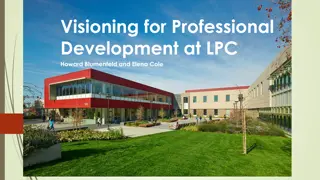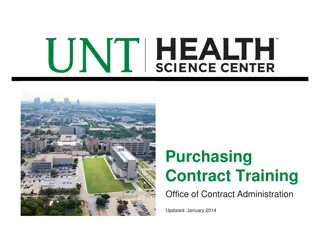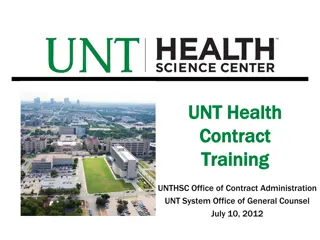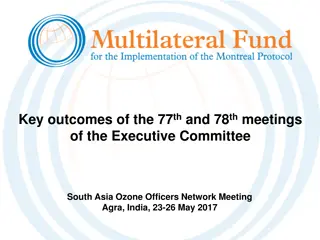Changes in Funding and Contracts for LPC Contractor Meetings
This slide deck published by PSNC offers comprehensive information on funding changes, contract alterations, and various schemes affecting LPC contractor meetings. It covers topics like Quality Payments scheme, NUMSAS, and other essential contract modifications. The deck provides essential updates and insights on funding impositions, Establishment Payments, Single Activity Fee, and more. Detailed slides are available for further reference on PSNC's website. Stay informed about the evolving landscape of community pharmacy in 2016/17 and beyond.
Download Presentation

Please find below an Image/Link to download the presentation.
The content on the website is provided AS IS for your information and personal use only. It may not be sold, licensed, or shared on other websites without obtaining consent from the author.If you encounter any issues during the download, it is possible that the publisher has removed the file from their server.
You are allowed to download the files provided on this website for personal or commercial use, subject to the condition that they are used lawfully. All files are the property of their respective owners.
The content on the website is provided AS IS for your information and personal use only. It may not be sold, licensed, or shared on other websites without obtaining consent from the author.
E N D
Presentation Transcript
Read and delete This slide deck has been published by PSNC for LPC use at contractor meetings It contains a range of slides covering the funding imposition and contract changes which can be selected as appropriate to the focus of your meeting A more detailed slide deck on the Quality Payments scheme is available at http://psnc.org.uk/services-commissioning/essential-services/quality- payments/ A more detailed slide deck on the NUMSAS is available at http://psnc.org.uk/services-commissioning/urgent-medicine-supply-service/ Further information, which can be used as background reading prior to using the presentation, is available via http://psnc.org.uk/contract-it/cpcf-changes- 201617-and-201718/ Last updated 26/2/17
Community pharmacy in 2016/17 and beyond final package psnc.org.uk/pharmacychanges #pharmacychanges
Overview Changes to funding Pharmacy Access Scheme Quality Payment scheme Pharmacy Integration Fund NUMSAS Other contract changes Judicial Review Questions
Funding imposition 2016/17 2.687 billion ( 113 million reduction) 4% reduction in funding (cf. 2015/16) 12% reduction from Dec 2016 - Mar 2017 cf. Nov 2016 levels Original plan was for 170 million reduction So eventual imposition was 57 million less than originally planned
Funding imposition 2017/18 2.592 billion 95 million reduction cf. 2016/17 208 million reduction = a further 3.4% reduction cf. 2015/16 7.4% reduction cf. Nov 2016 levels Beyond 2018 Subject to future consultation
Single Activity Fee Incorporates the: professional fee Practice Payment Repeat Dispensing payment monthly EPS payment Other fees (unlicensed medicines, appliances, CDs, etc) are not included One-off set up payment for EPS release 2 will cease at end of March 1.13/item Expected to rise in 2017/18 to 1.24/item
Establishment Payments Will be phased out over a number of years 1st December 2016 reduced by 20% compared to 2015/16 (equivalent to 6.7% reduction overall in 2016/17) 1st April 2017 further reduced by 40% compared to 2015/16 levels Proposed to cease by end of 2019/20
PSNC website: indicative income calculator Quality Payment
Summary of funding changes & pharmacy cashflow impact Funding cut 95m Funding cut 113m Further reduction in Establishment Payment by 40% Slight increase in Single Activity Fee @ rate of 1.24 per item Reduction in average Pharmacy Access Scheme Introduction of Quality Payments Margin recovery of 12m pcm ends Reduction in Establishment Payment by 20% Introduction of Single Activity Fee @ rate of 1.13 per item Introduction of Pharmacy Access Scheme Ongoing margin recovery of 12m pcm Jan 17 1st Feb 17 1st Dec 16 1st Apr 17 May 17 Jun 17 1st Jul 17 Aug 17 1st Mar 17 Jan 17 advance payment Dec 16 balancing payment Dec 16 advance payment Nov 16 balancing payment Oct 16 advance payment Sept 16 balancing payment Big Impact Month Dec 16 advance payment will be inflated as based on November s AIV For eligible pharmacies the first Quality Payment will be made in July 2017 Note: this payment is only made twice a year with April and Novembers balancing payments No changes to payments for contractors apart from usual fluctuations in AIV. Jan 17 advance payment will be lower as the AIV calculation will take into consideration the reduction in fees. Dec 16 balance payment will be less than the value of the advance payment Try the PSNC s Cashflow & Indicative Income Calculator to see how these changes will impact your pharmacy by visiting psnc.org.uk/fundingchanges and clicking on the Impact on contractor income dropdown.
Changes to reimbursement Changes previously agreed by PSNC non Part VIII products Cat M changes Changes to the margin survey to account for multiple suppliers of non-Part VIII and Cat C products Splitting the discount scale Changes to the way Cat A prices are set
Pharmacy Access Scheme (PhAS) Aim ensure that a baseline level of patient access to NHS community pharmacy services is protected Funded from overall CPCF funding (bar near-miss review category) PhAS pharmacies will receive an additional payment will be protected from full effect of the reduction in funding Payment will be based on the funding the pharmacy received in 2015/16 On average, roughly 11,600 in 2016/17 and 17,600 in 2017/18 This is roughly 2,900 per month in 2016/17 and 1,500 per month in 2017/18
Pharmacy Access Scheme (PhAS) If eligible on the list, no need to apply to join the scheme A pharmacy is eligible if it meets three criteria: Is more than a mile away from its nearest pharmacy by road walking distance Was on the Pharmaceutical List on 1st September 2016 Not in the top 25% of pharmacies by dispensing volume (prof fees) According to DH s original list, 1,356 pharmacies would receive funding based on criteria The list has subsequently been revised
Pharmacy Access Scheme (PhAS) Distance-selling pharmacies are not included LPS pharmacies are not included - although they may receive similar payments depending on the terms of their contract Eligibility is fixed to pharmacies on the published list (subject to review cases) Commenced on 1st December 2016 and runs to 31st March 2018 unknown what will happen after this time period
Pharmacy Access Scheme (PhAS) A review mechanism (administered by NHS England) is in place Aim - to allow for consideration of extenuating circumstances which may mean that access is not being protected in the way intended by the scheme Full details via psnc.org.uk/phas Grounds for review: Inaccuracy, e.g. if the pharmacy postcode is incorrect or the distance from the next pharmacy is calculated incorrectly
Pharmacy Access Scheme (PhAS) Physical feature anomalies, e.g. a semi-permanent roadblock meaning two pharmacies are then more than 1 mile from each other Can be requested beyond the initial 3 month review period, but within 3 months of the change in circumstances Evidence of the anomaly must be submitted and will need to demonstrate, on a balance of probabilities, that the normal 1-mile rule produces an unreasonable outcome in the particular circumstances of the case
Pharmacy Access Scheme (PhAS) If a semi-permanent road or bridge closure means that the nearest pharmacy is in fact more than a mile away, the first stage of the review will be passed successfully If the problem is that the distance to the nearest pharmacy is in fact less than a mile but the journey is particularly difficult, NHS England will need evidence of the level of difficulty and the problems surmounting that difficulty If a pharmacy satisfies the first stage of the test, to then qualify for the PhAS payment, the pharmacy would also have to demonstrate on a balance of probabilities that they were critical for access
Pharmacy Access Scheme (PhAS) In particular, it would need to demonstrate that a local population relies on that pharmacy and would be materially affected by its closing. The health needs of the population may be relevant to whether or not the local population is materially affected by the closure Near misses pharmacies between 0.8 and 1 miles from the next pharmacy; and in the top 20% of areas when ranked by Index of Multiple Deprivation the pharmacy will have to demonstrate on a balance of probabilities that they were critical for access
Quality Payments scheme Voluntary engagement contractors don t have to participate Derived from a PSNC proposal but the PSNC proposal was with full funding to recognise costs to tackle the DH move to even greater Rx volume focussed funding Payments will be made to community pharmacy contractors who meet certain quality criteria Payments will be made in 2017/18 Implementation commenced in December 2016
Eligibility to participate All pharmacies on the pharmaceutical list in England including Distance Selling Pharmacies including pharmacies receiving a Pharmacy Access Scheme (PhAS) payment Does not include Local Pharmaceutical Services (LPS) contracts but NHS England local teams and LPS contractors can theoretically include a similar concept in LPS contracts when they are reviewed
Funding 75m value in 2017/18 (from the overall 2.592bn CPCF funding) 100 points maximum per contractor Value of each point set at 64 = max of 6,400 But potentially a reconciliation payment in final payment for March 2018 (end May 2018) to pharmacies that have participated in the scheme The reconciliation payment received will depend on the number of points the contractor has achieved 128 cap on points value
PhAS and Quality Payments Pharmacies eligible for the Pharmacy Access Scheme will qualify for Quality Payments When the top-up funding that PhAS pharmacies receive is calculated, it is assumed that the contractor will achieve 100 points The value of those points is deducted before the final PhAS payment is set
Claiming payment 2 review points during the year at which contractors assess which requirements they have met and how many points they have achieved: 28th April 2017 24th November 2017 Declarations will be made to the BSA in April and November via a Smart Survey web-based form payments made with the final payment for those months i.e. end June 2017 and start of February 2018
Gateway criteria Pharmacies must first meet four gateway criteria: 1. Offering MURs or the NMS or must be registered to provide the NHS Urgent Medicine Supply Advanced Service (NUMSAS) 2. NHS Choices entry up to date 3. Ability to send and receive email via NHSmail 4. Ongoing utilisation of EPS There is no payment for passing the gateway criteria
Quality criteria Number of review points at which it can be claimed Points at any one review point Total points over the two review points Domain Criteria Written safety report at premises level available for inspection at review point, covering analysis of incidents and incident patterns (taken from an ongoing log), evidence of sharing learning locally and nationally, and actions taken in response to national patient safety alerts On the day of the review 80% of registered pharmacy professionals working at the pharmacy have achieved level 2 safeguarding status for children and vulnerable adults in the last two years On the day of the review, the results of the Community Pharmacy Patient Questionnaire from the last 12 months is publicly available on the pharmacy s NHS Choices page Patient Safety One 20 20 Patient Safety Two 5 10 Patient Experience One 5 5
Quality criteria Number of review points at which it can be claimed Points at any one review point Total points over the two review points Domain Criteria Public HealthOn the day of the review, the pharmacy is a Healthy Living Pharmacy level 1 (self-assessment) One 20 20 On the day of the first review, the pharmacy can demonstrate a total increase in access to Summary Care Records between 1 December 2016 and 28 April 2017 in comparison to the previous 5 months; and on the day of the second review, the pharmacy can demonstrate a total increase to access to Summary Care Records between 1 May 2017 and 24 November in comparison to the previous 7 months On the day of the review, the pharmacy s NHS 111 Directory of Services entry is up to date Digital Two 5 10 Digital Two 2.5 5
Quality criteria Number of review points at which it can be claimed Points at any one review point Total points over the two review points Domain Criteria On the day of the review, the pharmacy can show evidence of asthma patients, for whom more than 6 short acting bronchodilator inhalers were dispensed without any corticosteroid inhaler within a 6 month period, are referred to an appropriate health care professional for an asthma review. On the day of the review, 80% of all pharmacy staff working in patient facing roles are trained Dementia Friends Clinical Effectiveness Two 10 20 Workforce Two 5 10 Total number of points: 100
PSNCs view on the scheme Direction of travel is right and some useful enablers for the future Lack of specific funding is an issue, particularly for HLP Advise contractors to carefully consider which elements of the scheme they engage with and the costs that they will incur in comparison to the funding available for each element But we expect that most contractors will want to participate Longevity of the scheme is unclear and will be influenced by NHS England s response to the Murray Review The fine details related to implementation should have been finalised by DH/NHS England before imposition
Next steps Initial guidance on Gateway criteria was published by NHS England in December Further guidance on quality criteria published at end of February 2017 PSNC Briefings and associated resources available at psnc.org.uk/quality HLP Briefing and resources Dementia Friends Briefing Asthma Interventions Briefing PharmOutcomes modules available to help track progress and make referrals/records for the asthma criterion
The Pharmacy Integration Fund 5 year fund 300m??? 2016/17 & 2017/18 value now 42m Urgent care workstream emergency supply, DoS improvement work, NHS 111 integration, deploying pharmacists in urgent care settings (from April 2017) Care home workstream deployment of pharmacists from April 2017 and workforce development HEE workforce plan for pharmacy professionals in primary care
The Pharmacy Integration Fund Educational grants for community pharmacists to access postgraduate clinical pharmacy education and training courses up to diploma level (from April 2017) A programme of pharmacy technician clinical leadership development (from April 2017) Medicines Digital Strategy work (Domain E) NHS Digital Transfer of care data from NHS 111 and hospitals to community pharmacies and post-event messaging
The Pharmacy Integration Fund NHSmail 2 rollout to community pharmacy Murray Review will inform future decisions on how the fund is deployed Stakeholder reference group to be established in 2017
NHS Urgent Medicines Supply Advanced Service (NUMSAS) pilot Advanced service from December 2016 end March 2018 Only NHS 111 referrals not walk-in patients Service specification published at the end of November 2016 Funded from the Pharmacy Integration Fund, i.e. over and above the core funding
NHS Urgent Medicines Supply Advanced Service (NUMSAS) pilot Record keeping requirements and IT support NHS England intend to publish guidance on the service Started to rollout in December 2016 PSNC has issued guidance for contractors, including our view on the cost of provision Implications for local services Evaluation of service commencing in January 2017
Spreading MAS NHS England will test the technical integration and clinical governance framework for referral to community pharmacy from NHS 111 for people who need immediate help with urgent minor ailments Aim to develop an evidence-based, clinical and cost effective approach to how community pharmacists and their teams contribute to urgent care NHS England will encourage all CCGs to adopt this joined-up approach by April 2018
Changes to market entry consolidation of pharmacies PSNC proposed changes to prevent a new pharmacy stepping in straight away if a chain closes a branch or two businesses merge Regulations laid in December 2016 which provide some protection for pharmacies that consolidate, where this does not create a gap in provision
Judicial Review PSNC sought a Judicial Review of the Secretary of State s October decision What is a Judicial Review? Sought permission from the High Court to apply for the Judicial Review on the grounds that it believes the Secretary of State failed to carry out a lawful consultation PSNC s application raises a number of concerns about the consultation, including: The DH s failure to disclose the fact that it had carried out an indicative analysis of pharmacies profitability based on Companies House data as part of its Impact Assessment
Judicial Review The delay in providing this analysis to PSNC after the publication of the Impact Assessment The validity of the DH analysis including the sample size and the use of accounting returns, rather than economic returns, as the basis for the assessment of pharmacies economic viability and how they might be affected by the changes The DH s failure to analyse what the levels of pharmacy closures may be The National Pharmacy Association is named as an interested party in PSNC s application and has launched its own JR
Judicial Review The High Court granted PSNC permission for a Judicial Review (21st December 2016) The hearing was to be expedited and was due to be heard in the week commencing 6 February 2017 The Secretary of State sought a later hearing date This matter was considered on 12th January 2017 case now to be rolled-up with the NPA case and heard week commencing 20th March
Judicial Review Likely outcomes? Implications for contractors
Questions psnc.org.uk/pharmacychanges
